Chapter 6: Order quantities and reorder levels
Chapter learning objectives
Upon completion of this chapter you will be able to:
- identify, explain and calculate the costs of ordering and holding inventory (including buffer inventory)
- calculate and interpret the optimal order quantities
- calculate and interpret the optimal order quantities when quantity discounts are available
- produce calculations to minimise inventory costs when inventory is gradually replenished
- describe and apply appropriate methods for establishing reorder levels where demand in the lead time is constant
1 The costs of holding inventory
Reasons for holding inventory
The main reason that an organisation will hold inventory is inorder to make sure that customer demands are met as soon as possible.
- If customer demands are met, customers will be happy.
- If customers are happy, sales and, therefore, profits will increase.
- Holding raw material inventory will prevent hold-ups in the production process of manufacturing companies.
Holding costs
Costs associated with holding inventory are known as holding costs.
- Holding costs include the following:
- interest on capital tied up in inventory
- cost of storage space
- cost of insurance.
- Buffer inventory is a basic level of inventory held for emergencies and to prevent stock-outs from occurring. It is also known as safety inventory or the minimum inventory level.
- Holding costs can be distinguished between fixed holding costs and variable holding costs.
- Fixed holding costs include the cost of storage space and the cost of insurance. Note that the cost of storage space may be a stepped fixed cost if increased warehousing is needed when higher volumes of inventory are held.
- Variable holding costs include interest on capital tied up in inventory. The more inventory that is held, the more capital that is tied up.
- Holding costs are often stated as being valued at a certain percentage of the average inventory held.
- Note: Stock-out costs are the costs associated with running out of inventory and they include loss of sales, loss of customers (and customer goodwill) and reduced profits.
Ordering costs
Every time an order is placed to purchase materials, an order cost is incurred. The costs associated with placing orders are known as ordering costs and include administrative costs and delivery costs.
- Administrative costs of placing an order are usually a fixed cost per order. The total administrative costs of placing orders will increase in proportion to the number of orders placed. They therefore exhibit the behaviour of variable costs.
- Delivery costs are usually a fixed charge per delivery (order). The total delivery costs will also increase in direct proportion to the number of deliveries in a period, and therefore behave as variable costs.
- If inventory levels are too low, there is a danger that the number of stock-outs will increase and there will therefore be an increase in the number of orders placed.
- An increase in the number of orders will cause a corresponding increase in ordering costs.
- It is essential, therefore, to maintain inventory at a level (known as the optimum level) where the total of holding costs, ordering costs and stock-out costs are at a minimum. This is the main objective of inventory control.

 Illustration 1 – The cost of holding inventory
Illustration 1 – The cost of holding inventory
A company uses components at the rate of 6,000 units per year,which are bought in at a cost of £1.20 each from the supplier. Thecompany orders 1,000 units each time it places an order and the averageinventory held is 500 units. It costs $20 each time to place an order,regardless of the quantity ordered.
The total holding cost is 20% per annum of the average inventory held.



 Solution
Solution

Workings
Annual holding cost
= average inventory held x cost per unit × 20%
= 500 units × $1.20 × 20%
= $120
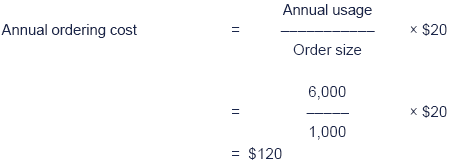


 Test your understanding 1
Test your understanding 1
A company has recorded the following details for Component 427 which is sold in boxes of 10 components.

Component 427 is currently ordered in batches of 240 boxes at a time. The average inventory held is 120 boxes.
Required:
Calculate the annual holding cost and the annual ordering cost for Component 427.

2 The economic order quantity (EOQ)
EOQ
 The EOQ is the reorder quantity which minimises the total costsassociated with holding and ordering inventory (i.e. (holding costs +ordering costs) are at a minimum at the EOQ).
The EOQ is the reorder quantity which minimises the total costsassociated with holding and ordering inventory (i.e. (holding costs +ordering costs) are at a minimum at the EOQ).
We can estimate the EOQ graphically by plotting holding costs, ordering costs and total costs at different levels of activity.
- Note that the EOQ is found at the point where total costs (holding + ordering) are at a minimum.
- Reading from the graph this is somewhere between 3,000 and 3,200 barrels.
- This is the same point at which holding costs are equal to ordering costs.
- Unfortunately it is only possible to estimate the EOQ by drawing a graph.
- Fortunately there is a formula that allows us to calculate the EOQ more accurately and more speedily.
EOQ formula
The formula for the EOQ (or Q) is as follows:

Where:
D = Demand per annum
Co = Cost of placing one order
Ch = Cost of holding one unit for one year
Q = Reorder quantity (EOQ)
Note that the formula for the EOQ is provided in your exam. Youmust make sure that you know what the different symbols represent sothat you can use the formula correctly.
EOQ assumptions
 There are a number of important assumptions and formulae related to the EOQ that you should note.
There are a number of important assumptions and formulae related to the EOQ that you should note.
- Average inventory held is equal to half of the EOQ = EOQ/2.
- The number of orders in a year = Expected annual demand/EOQ.
- Total annual holding cost = Average inventory (EOQ/2) x holding cost per unit of inventory.
- Total annual ordering cost = Number of orders x cost of placing an order.
- There is also a formula that allows us to calculate the Total Annual Costs (TAC) i.e. the total of purchasing costs, holding costs and ordering costs:
Total Annual Cost = PD + (Co x D/Q) + (Ch x Q/2)
Where:
P = Purchase cost per unit
D = Demand per annum
Co = Cost of placing one order
Ch = Cost of holding one unit for one year
Q = Reorder quantity (EOQ)
 Note that the formula for the TAC is not provided in your exam.
Note that the formula for the TAC is not provided in your exam.

 Illustration 2 – The economic order quantity (EOQ)
Illustration 2 – The economic order quantity (EOQ)
A company uses components at the rate of 500 units per month, whichare bought in at a cost of $1.20 each from the supplier. It costs $20each time to place an order, regardless of the quantity ordered.
The total holding cost is 20% per annum of the value of inventory held.



 Solution
Solution

Workings
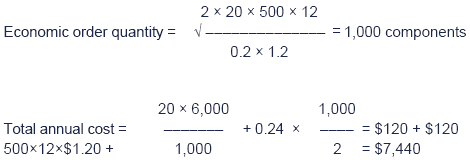


 Test your understanding 2
Test your understanding 2
A company is planning to purchase 90,800 units of a particular itemin the year ahead. The item is purchased in boxes each containing 10units of the item, at a price of $200 per box. A safety inventory of 250boxes is kept.
The cost of holding an item in inventory for a year (includinginsurance, interest and space costs) is 15% of the purchase price. Thecost of placing and receiving orders is to be estimated from cost datacollected relating to similar orders, where costs of $5,910 wereincurred on 30 orders. It should be assumed that ordering costs changein proportion to the number of orders placed. 2% should be added to theabove ordering costs to allow for inflation. Assume that usage of theitem will be even over the year.


3 The EOQ with discounts
Quantity discounts
It is often possible to negotiate a quantity discount on the purchase price if bulk orders are placed.
- If a quantity discount is accepted this will have the following effects:
- The annual purchase price will decrease.
- The annual holding cost will increase.
- The annual ordering cost will decrease.
- To establish whether the discount should be accepted or not, the following calculations should be carried out.
- Calculate TAC with the discount.
- Compare this with the annual costs without the discount (at the EOQ point).
EOQ when quantity discounts are available
The steps involved in calculating the EOQ when quantity discounts are available are as follows:
(1) Calculate the EOQ, ignoring discounts.
(2) If the EOQ is smaller than theminimum purchase quantity to obtain a bulk discount, calculate the totalfor the EOQ of the annual inventory holding costs, inventory orderingcosts and inventory purchase costs.
(3) Recalculate the annual inventoryholding costs, inventory ordering costs and inventory purchase costs fora purchase order size that is only just large enough to qualify for thebulk discount.
(4) Compare the total costs when theorder quantity is the EOQ with the total costs when the order quantityis just large enough to obtain the discount. Select the minimum costalternative.
(5) If there is a further discountavailable for an even larger order size, repeat the same calculationsfor the higher discount level.

 Illustration 3 – The EOQ with discounts
Illustration 3 – The EOQ with discounts
A company uses components at the rate of 500 units per month, whichare bought in at a cost of $1.20 each from the supplier. It costs $20each time to place an order, regardless of the quantity ordered.
The supplier offers a 5% discount on the purchase price for orderquantities of 2,000 items or more. The current EOQ is 1,000 units.
The total holding cost is 20% per annum of the value of inventory held.
Required:
Should the discount be accepted?


 Solution
Solution
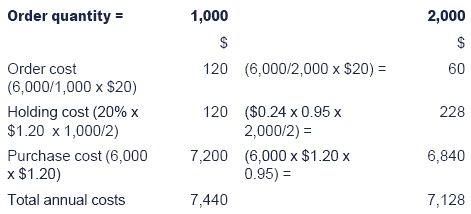
The discount should be accepted because it saves the company $312 ($7,440 – $7,128).


 Test your understanding 3
Test your understanding 3
Watton Ltd is a retailer of beer barrels. The company has an annualdemand of 36,750 barrels. The barrels cost $12 each. Fresh supplies canbe obtained immediately, but ordering costs and the cost of carriageinwards are $200 per order. The annual cost of holding one barrel ininventory is estimated to be $1.20. The economic order quantity has beencalculated to be 3,500 barrels.
The suppliers introduce a quantity discount of 2% on orders of atleast 5,000 barrels and 2.5% on orders of at least 7,500 barrels.
Required:
Determine whether the least-cost order quantity is still the EOQ of 3,500 barrels.

4 Gradual replenishment of inventory
Gradual replenishment of inventory
The situations we have looked at so far have involved inventorylevels being replenished immediately when organisations buy inventoryfrom suppliers. Similar problems are faced by organisations whoreplenish inventory levels gradually by manufacturing their own productsinternally.
- The decisions faced by organisations that manufacture and store their own products involve deciding whether to produce large batches at long intervals OR produce small batches at short intervals.
- An amended EOQ model is used to help organisations to decide which course of action to take.
- The amended EOQ model is known as the EBQ (economic batch quantity) model.
- As the items are being produced, there is a machine setup cost. This replaces the ordering cost of the EOQ.
- In the EOQ, inventory is replenished instantaneously whereas here, it is replenished over a period of time.
- Depending on the demand rate, part of the batch will be sold or used while the remainder is still being produced.
- For the same size of batch (Q), the average inventory held in the EOQ model (Q/2) is greater than the average in this situation (see diagram on the next page).
- The EBQ model can be shown graphically as follows.
Inventory
(units)
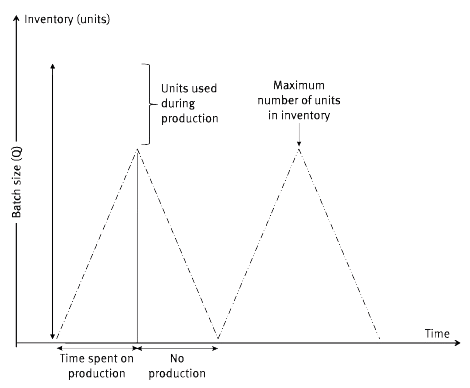
- The maximum inventory level will never be as great as the batch size, because some of the batch will be used up while the remainder is being produced.
The EBQ
The EBQ model is primarily concerned with determining the number ofitems that should be produced in a batch (compared to the size of anorder with the EOQ).
The formula for the EBQ is as follows:

Where:
Q = Batch size
D = Demand per annum
Ch = Cost of holding one unit for one year
Co = Cost of setting up a batch ready to be produced
R = Annual replenishment rate
 Note that the formula for the EBQ is provided in your exam. You mustmake sure that you know what the different symbols represent so that youcan use the formula correctly.
Note that the formula for the EBQ is provided in your exam. You mustmake sure that you know what the different symbols represent so that youcan use the formula correctly.

 Large or small batches?
Large or small batches?
- Producing large batches at long intervals will lead to low machine setup costs (as fewer machine setups will be needed) and high holding costs (high average inventory levels as more inventory held).
- Producing small batches at short intervals will lead to high machine setup costs (as more machine setups will be needed) and low holding costs (low average inventory levels as less inventory held).


 Illustration 4 – Gradual replenishment of inventory
Illustration 4 – Gradual replenishment of inventory
The following is relevant for Item X:
- Production is at a rate of 500 units per week.
- Demand is 10,000 units per annum; evenly spread over 50 working weeks.
- Setup cost is $2,700 per batch.
- Storage cost is $2.50 per unit for a year.
Required:
Calculate the economic batch quantity (EBQ) for Item X.


 Solution
Solution
Annual production rate, R = 500 x 50 = 25,000 units
Annual demand rate = 10,000 units
Cost per setup, Co = $2,700
Cost of holding one item in inventory per year, Ch = $2.50



 Test your understanding 4
Test your understanding 4
AB Ltd makes a component for one of the engines that it builds. Ituses, on average, 2,000 of these components, steadily throughout theyear. The component costs $16 per unit to make and it costs anadditional $320 to setup the production process each time a batch ofcomponents is made. The holding cost per unit is 10% of the unitproduction cost. The company makes these components at a rate of 200 perweek, and the factory is open for 50 weeks per annum.
Required:
Calculate the EBQ.

5 Reorder levels
Reorder level
Reorder level – when inventory held reaches the reorder level then a replenishment order should be placed.
- Lead time – this is the time expected to elapse between placing an order and receiving an order for inventory.
- Reorder quantity – when the reorder level is reached, the quantity of inventory to be ordered is known as the reorder or EOQ.
- Demand – this is the rate at which inventory is being used up. It is also known as inventory usage.
- If the demand in the lead time is constant, the reorder level is calculated as follows:
Reorder level (when demand in lead time is constant) = Usage x Lead time

 Illustration 5 – Reorder levels
Illustration 5 – Reorder levels
A company uses Component M at the rate of 1,500 per week. The timebetween placing an order and receiving the components is five weeks. Thereorder quantity is 12,000 units.
Required:
Calculate the reorder level.


 Solution
Solution



 Test your understanding 5
Test your understanding 5
A national chain of tyre fitters stocks a popular tyre for which the following information is available:
Usage – 175 tyres per day
Lead time – 16 days
Reorder quantity – 3,000 tyres
Based on the data above, at what level of inventory should areplenishment order be issued in order to ensure that there are nostock-outs?
A 2,240
B 2,800
C 3,000
D 5,740


 Re-order levels when lead time and demand are not constant
Re-order levels when lead time and demand are not constant
Re-order level = maximum usage × maximum lead time
Maximum inventory level = reorder level + reorder quantity – (minimum usage × minimum lead time)
Minimum inventory level = reorder level – (average usage × average lead time)
Average inventory = (reorder quantity / 2) + minimum inventory

6 Chapter summary
Test your understanding answers

 Test your understanding 1
Test your understanding 1
Annual holding cost = average inventory held x cost per box x 10%
= 120 x $20 x 10% = $240
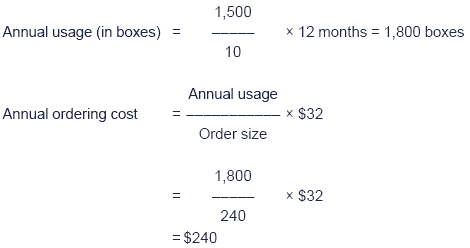


 Test your understanding 2
Test your understanding 2

Workings
To avoid confusion this question is best tackled by working in boxes not units.

26 orders per annum is equivalent to placing an order every 2 weeks (52 weeks / 26 orders).


 Test your understanding 3
Test your understanding 3
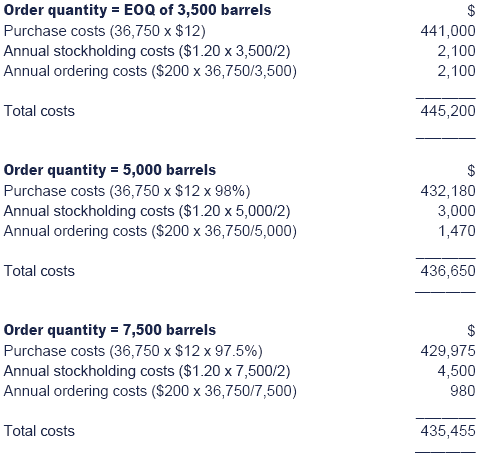
Total costs are minimised with an order size of 7,500 barrels.


 Test your understanding 4
Test your understanding 4



 Test your understanding 5
Test your understanding 5
B Reorder level = Usage x Lead time
= 175 x 16
= 2,800 units

|
Created at 5/24/2012 5:07 PM by System Account
(GMT) Greenwich Mean Time : Dublin, Edinburgh, Lisbon, London
|
Last modified at 5/25/2012 12:53 PM by System Account
(GMT) Greenwich Mean Time : Dublin, Edinburgh, Lisbon, London
|
|
|
|
 |
Rating
:
|
 Ratings & Comments
(Click the stars to rate the page) Ratings & Comments
(Click the stars to rate the page)
|
 |
Tags:
|
|
|
|
|